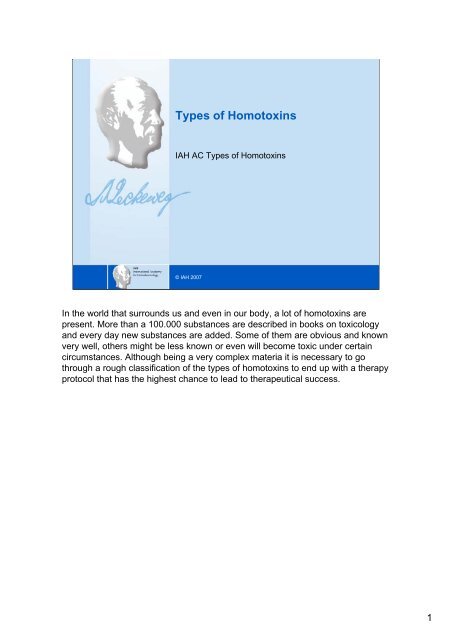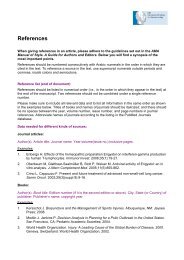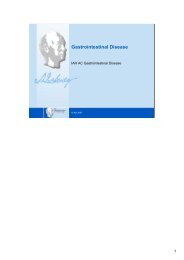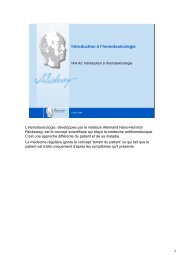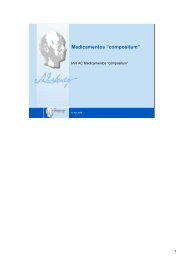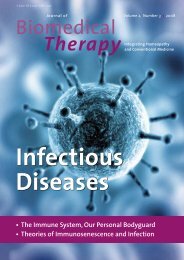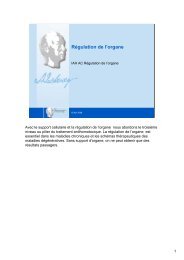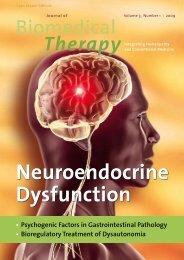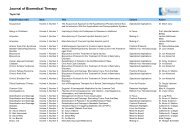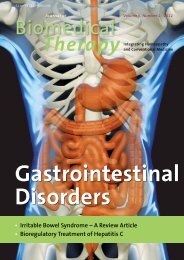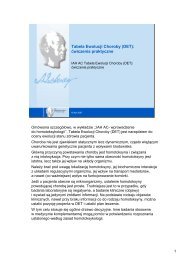Types of Homotoxins
Types of Homotoxins
Types of Homotoxins
Create successful ePaper yourself
Turn your PDF publications into a flip-book with our unique Google optimized e-Paper software.
<strong>Types</strong> <strong>of</strong> <strong>Homotoxins</strong><br />
IAH AC <strong>Types</strong> <strong>of</strong> <strong>Homotoxins</strong><br />
© IAH 2007<br />
In the world that surrounds us and even in our body, a lot <strong>of</strong> homotoxins are<br />
present. More than a 100.000 substances are described in books on toxicology<br />
and every day new substances are added. Some <strong>of</strong> them are obvious and known<br />
very well, others might be less known or even will become toxic under certain<br />
circumstances. Although being a very complex materia it is necessary to go<br />
through a rough classification <strong>of</strong> the types <strong>of</strong> homotoxins to end up with a therapy<br />
protocol that has the highest chance to lead to therapeutical success.<br />
1
Objective:<br />
• Identify the different types <strong>of</strong> homotoxins present in the natural<br />
environment.<br />
• Describe the effects <strong>of</strong> homotoxins on living organisms.<br />
• Indicate the possible antihomotoxic preparations that can help<br />
neutralise them.<br />
© IAH 2007<br />
2<br />
The objectives <strong>of</strong> this lecture are to identify the different types <strong>of</strong> homotoxins<br />
present in our natural environment, to describe their toxic effects on the human<br />
organism and to indicate the possible preparations that might help to neutralise<br />
them.<br />
For a general drainage and detoxification we refer to the lecture IAH AC Drainage<br />
and Detoxification<br />
2
Agenda:<br />
• Definition <strong>of</strong> homotoxin<br />
• <strong>Types</strong> <strong>of</strong> homotoxins<br />
• Chemical toxins<br />
• Insidious toxins<br />
• Diet and toxicity<br />
• Drugs as toxins<br />
• Neural interference fields<br />
• Psychotoxins<br />
© IAH 2007<br />
3<br />
3
Definition <strong>of</strong> a homotoxin<br />
• A homotoxin is any substance that creates a direct or indirect<br />
toxic burden in the human organism.<br />
© IAH 2007<br />
4<br />
A homotoxin is defined as any substance that has a direct or indirect damaging<br />
effect on the human organism. Not the substance in itself is the most important.<br />
Crucial is its effect on the organism.<br />
4
<strong>Types</strong> <strong>of</strong> homotoxins<br />
• Exogenous homotoxins<br />
• Extern toxic burdens that comes into the body or interferes<br />
with it (e.g. arsenic, tobacco smoke, heavy metals etc.)<br />
• Endogenous homotoxins<br />
• Created in the body, mostly as consequence <strong>of</strong> metabolic<br />
processes (e.g. ammoniac, CO 2 , etc.)<br />
© IAH 2007<br />
5<br />
We divide homotoxins into two big groups: the exogenous and endogenous ones.<br />
Exogenous homotoxins are substances that come from the environment into the<br />
body and have a direct or indirect toxic effect on tissues, organs or regulation<br />
mechanisms. Even a healthy lifestyle is no guarantee for being free <strong>of</strong> exogenous<br />
homotoxins as in a lot <strong>of</strong> them we can barely influence the intake (dust in the air,<br />
radiations, gasses, etc…). Some <strong>of</strong> them are toxic in small dosages, others need<br />
a higher doses or prolonged intake <strong>of</strong> smaller quantities. Some <strong>of</strong> the exogenous<br />
homotoxins become extremely toxic in combination with other substances.<br />
Avoidance behaviour is not enough to stay clean <strong>of</strong> toxins as a huge part may<br />
come in without the person is knowing it.<br />
Endogenous homotoxins are created by the organism itself. Hereunder we find a<br />
lot <strong>of</strong> metabolic intermediary or end products. Even substances that under normal<br />
circumstances are present in the body but that are toxic if they accumulate must<br />
be seen as homotoxins and become therapeutically important when we can’t<br />
eliminate them over normal physiological processes.<br />
5
“The dose makes the poison”<br />
Paracelsus<br />
© IAH 2007<br />
6<br />
Centuries ago Paracelsus already referred to the importance <strong>of</strong> a dose to call a substance toxic.<br />
Arsenic is commonly known as a very toxic substance but few people are aware that we find<br />
arsenic in a lot <strong>of</strong> food we daily eat,… but only in very minor doses. Higher dosages are deathly,<br />
very low dosages <strong>of</strong> a toxin can even be beneficial to the organism. Other substances we declare<br />
without any doubt as healthy can become extremely toxic in high doses (to drink more clean<br />
water than 30% <strong>of</strong> our body weight within 24 hours is deathly dangerous). So there is more than<br />
just the substance itself that makes it toxic. We should look at<br />
•the substance<br />
•the (repeated) doses<br />
•the time <strong>of</strong> interaction with the organism<br />
•the adaptation to the intoxication<br />
•the susceptibility <strong>of</strong> the organism<br />
•the storage capacities (ECM)<br />
•the excretion capacities<br />
•the (potentialising or inhibiting) interactions with other substances out <strong>of</strong> the direct environment <strong>of</strong><br />
the organism<br />
•The combination <strong>of</strong> the doses and time <strong>of</strong> impact <strong>of</strong> the toxin might cause unexpected intoxication<br />
effects. A high acute doses <strong>of</strong> a toxin is almost always dangerous but so so might be a long term<br />
intoxication with a small doses.<br />
So, in fact we could say that a homotoxin only becomes toxic in the organism under well defined<br />
conditions and that not every homotoxin has the same toxicity degree <strong>of</strong> toxicity for every human<br />
organism. We can put down guidelines and standards but they are not applicable without nuances<br />
to all human beings in the same way.<br />
6
<strong>Homotoxins</strong>:<br />
• Chemical toxins<br />
• Insidious toxins<br />
• Diet and toxicity<br />
• Drugs as toxins<br />
• Neural interference fields<br />
• Psychotoxins<br />
© IAH 2007<br />
7<br />
Beside the homotoxin itself aspects <strong>of</strong> lifestyle and environment have to be<br />
studied. There are chemical aspects, nutritional aspects, modern medication or<br />
pharmacological aspects and even factors that are related to regulation rigidity<br />
and interference fields. So these are the main factors determining homotoxic<br />
overload.<br />
7
Factors determining homotoxic<br />
overload<br />
Chemical poisoning<br />
© IAH 2007<br />
In these modern times with high industrial environment, synthetic molecules,<br />
social bereavement, psychological pressure and suppression medicine, chemical<br />
poisoning will find a lot <strong>of</strong> potentizing factors to create toxicity in the human body.<br />
As mentioned before, chemical homotoxic overload is not that easy to escape<br />
from as in highly economically developed countries they became part <strong>of</strong> life due<br />
to governmental choices made in the past and consequential environmental<br />
pollution. Cosmic radiations (ozone layer damaging), radioactivity, pseudoestrogens<br />
in fish, heavy metals in the direct environment,… they all are the same<br />
for everyone, independent the lifestyle or choices made. Even moving out from a<br />
region is not always a solution as some <strong>of</strong> the toxic substances are travelling over<br />
the air to so called pure and natural regions.<br />
8
Chemical poisoning: toxicological criteria<br />
• Bioaccumulation<br />
• Tendency <strong>of</strong> a substance to accumulate in the tissues <strong>of</strong> live<br />
organisms by bioaccumulation<br />
• Related to hydrophobic and lipophylic characteristics<br />
© IAH 2007<br />
9<br />
Paracelsus stated that the doses makes the poison. In this way it looks like that<br />
only a high doses <strong>of</strong> a toxin will create an intoxication status which is not always<br />
true. Even very little amounts <strong>of</strong> chemical loads, repeated over decades, can<br />
create a bioaccumulation that becomes extremely dangerous after a long period.<br />
In the lecture ‘IAH AC Matrix histology and physiology’ we mentioned already that<br />
there are at least 3 ways in which toxins can get incorporated into the structure <strong>of</strong><br />
the extra cellular matrix. This can be due to a positive charge (the ECM structure<br />
is predominantly negative charged), by hydrophilic characteristics or due to pure<br />
mechanic aspects (size <strong>of</strong> the toxin). So, even presented in very small amounts<br />
at the time, bioaccumulation can be the cause that a toxic level is reached, even<br />
if it takes years to do so.<br />
Still now in Europe, older people are found that were active in the flora sector and<br />
have still a high accumulation <strong>of</strong> DDT in the liver, a substance that has been<br />
banned for more than 2 decades now.<br />
9
Chemical poisoning: toxicological criteria<br />
• Toxicity<br />
• Adverse effects on human and animal health<br />
• Can be divided into seven basic characteristics...<br />
© IAH 2007<br />
10<br />
The toxic effect <strong>of</strong> a chemical substance is dependent on certain criteria. Not all<br />
chemicals are toxic in the same way for living species. Some <strong>of</strong> them are<br />
extremely toxic for plants and almost not to animals or humans and vice versa.<br />
That is why a more specific and closer look at this materia is needed.<br />
10
Chemical poisoning: toxicological criteria<br />
• Toxicity<br />
• Acute lethality<br />
• Sublethal effects on non-mammalian species<br />
• Sublethal effects on plants<br />
• Sublethal effects on mammals<br />
• Teratogenicity<br />
• Genotoxicity/mutagenicity<br />
• Carcinogenicity<br />
© IAH 2007<br />
11<br />
For most chemicals the acute lethal dose is described in pr<strong>of</strong>essional literature. We have to be<br />
aware that not the single lethal dose alone is toxic but also that bioaccumulation is possible and<br />
repeated dosages are added to residual amounts <strong>of</strong> an earlier intake, a lethal dose can be<br />
reached. Think about the bioaccumulation <strong>of</strong> heavy metals like lead.<br />
Toxic effects can be seen on non mammalian species and can have an effect on long term due to<br />
the food cycle. The same is the case for poisoned plants.<br />
The sublethal effects <strong>of</strong> chemicals on mammals are quite well described but <strong>of</strong>ten forgotten in the<br />
patient’s history. Work related intoxications, domicile (industrial or not), chemically treated food,<br />
especially in the long term can cause sublethal intoxicating effects.<br />
Some chemicals can induce consequences in embyological development. In this case the toxicity<br />
in the mother causes deviations in the child. This is not only the case with pure chemicals out <strong>of</strong><br />
the environment but also chemicals or substances used in pharmacology (e.g. S<strong>of</strong>tenon children<br />
in the 60-ties)<br />
Other chemicals have a genotoxicity and are the cause <strong>of</strong> genetic dysfunctions. This has <strong>of</strong>ten not<br />
only physical but also physiological consequences.<br />
Many substances are known to be carcinogenic. They are described in pr<strong>of</strong>essional literature due<br />
to their carcinogenic properties. Also here we see both: the acute toxic doses that triggers cell<br />
dedifferentiation and accumulated dosages that after long term induce the same.<br />
11
Chemical poisoning: principal pollutants<br />
• Acidifying substances<br />
• Ammonia<br />
• Nitrogen oxides<br />
• Sulfur dioxide, etc.<br />
© IAH 2007<br />
12<br />
The PH <strong>of</strong> the cellular environment is extremely important and the slightest deviations might<br />
cause dysfunctions or even irreversible damage.<br />
Ammonia is a product <strong>of</strong> protein catabolism and is metabolized by the liver. Normal blood<br />
ammonia levels range from 80-110 mcg/dL. Theoretically, patients with liver dysfunction are at<br />
increased risk for ammonia toxicity; we even measure ammonia as a sign <strong>of</strong> liver failure.<br />
NOx is a generic term for the various nitrogen oxides produced during combustion. They are<br />
believed to aggravate asthmatic conditions, react with the oxygen in the air to produce ozone,<br />
which is also an irritant and eventually form nitric acid when dissolved in water. When dissolved in<br />
atmospheric moisture the result can be acid rain which can damage both trees and entire forest<br />
ecosystems, with the human being at the end <strong>of</strong> the chain<br />
Sulfur dioxide is sometimes used as a preservative in alcoholic drinks, or dried fruits due to its<br />
antimicrobial properties. The preservative is used to maintain the appearance <strong>of</strong> the fruit rather<br />
than prevent rotting. This can give fruit a distinctive chemical taste.<br />
Sulfur dioxide is also a good reductant. In the presence <strong>of</strong> water, sulfur dioxide is able to<br />
decolorize substances that can be reduced by it; thus making it a useful reducing bleach for<br />
papers and delicate materials such as clothes. The emissions <strong>of</strong> tons <strong>of</strong> sulphur dioxide over<br />
decades is one <strong>of</strong> the main causes <strong>of</strong> acid rain.<br />
12
Chemical poisoning: principal pollutants<br />
• Metals and metalloids...<br />
• Cadmium<br />
• Mercury<br />
• Lead<br />
© IAH 2007<br />
13<br />
Heavy metals are all around in the modern industrial environment.<br />
Cadmium is one <strong>of</strong> the few substances in nature that have absolutely no value to living beings.<br />
Due to bioaccumulation, even in very small concentrations, isolated or in combination with other<br />
substances it is extremely toxic for living organisms and eco systems. Inhaled cadmium gasses<br />
are highly toxic to the kidneys and lungs. Oral intake can damage kidneys and liver severely. A lot<br />
<strong>of</strong> reactions and binding with cadmium are known to be cancer inducing. Cadmium intoxication<br />
can lead to the itai-itai syndrome, Japanese for ‘pain-pain’ disease. Emitted cadmium does end up<br />
in our bodies because it is taken up by plants and in this way comes into the food chain.<br />
Especially our detoxifying organs (kidneys and liver) are damaged by this exogenous homotoxin<br />
and therefore it is double dangerous as intoxication as it makes other toxins less possible to<br />
eliminate them.<br />
Mercury is used in lots <strong>of</strong> modern materials and is even used in dentistry (amalgam dental<br />
fillings). Human activities, like the application <strong>of</strong> agricultural fertilizers and industrial wastewater<br />
disposal, are examples <strong>of</strong> how humans release mercury directly into the soil or water. The<br />
mercury that is released in the environment ends up in surface water or soils eventually. When the<br />
pH values in acidic surface waters are between five and seven, the mercury concentrations in the<br />
water will increase. This is due to the mobilization <strong>of</strong> mercury in the ground near a water source.<br />
Microorganisms are able to convert the mercury that reaches the surface water to methyl mercury<br />
and most organisms absorb this substance quickly. Methyl mercury is also known to cause nerve<br />
damage. Fish are among the organisms that absorb methyl mercury in great amounts from water.<br />
As a consequence, methyl mercury accumulates in fish and passes into the food chain. The<br />
deleterious effects <strong>of</strong> mercury consumed by animals that eat fish include reproductive failure,<br />
damage to intestines, stomach disruption, DNA alteration, and kidney damage.<br />
Lead is a poisonous metal that can damage nervous connections (especially in young children)<br />
and cause blood and brain disorders. Long term exposure to lead or its salts (especially soluble<br />
salts or the strong oxidant PbO2) can cause nephropathy, and colic-like abdominal pains. The<br />
historical use <strong>of</strong> lead acetate (also known as sugar <strong>of</strong> lead) by the Roman Empire as a sweetener<br />
for wine is considered by some to be the cause <strong>of</strong> the dementia which affected many <strong>of</strong> the<br />
Roman Emperors. At one point in time, some lead compounds, because <strong>of</strong> their sweetness, were<br />
used by candy makers. Although this has been banned in industrialized nations, there was a 2004<br />
scandal involving lead-laced Mexican candy being eaten by children in California<br />
13
Chemical poisoning: principal pollutants<br />
• Organic compounds...<br />
• Non-halogenated compounds:<br />
• Aliphatic compounds (formaldehyde, methane)<br />
• Aromatic compounds (benzene, toluene)<br />
• Halogenated compounds:<br />
• Aliphatic compounds (chlor<strong>of</strong>luorocarbons, trichloroethane)<br />
• Aromatic compounds (chlorobenzene, dioxins)<br />
© IAH 2007<br />
14<br />
Between the chemicals also a lot <strong>of</strong> halogen and non-halogen compounds are extremely toxic and<br />
even can cancerogenous.<br />
Because formaldehyde resins are used in many construction materials, including plywood, carpet,<br />
and spray-on insulating foams, and because these resins slowly give <strong>of</strong>f formaldehyde over time,<br />
formaldehyde is one <strong>of</strong> the more common indoor air pollutants. At concentrations above 0.1 mg/kg<br />
in air, inhaled formaldehyde can irritate the eyes and mucous membranes, resulting in watery<br />
eyes, headache, a burning sensation in the throat, and difficulty breathing.<br />
Benzene exposure has serious health effects. Breathing high levels <strong>of</strong> benzene can result in<br />
death, while low levels can cause drowsiness, dizziness, rapid heart rate, headaches, tremors,<br />
confusion, and unconsciousness. Eating or drinking foods containing high levels <strong>of</strong> benzene can<br />
cause vomiting, irritation <strong>of</strong> the stomach, dizziness, sleepiness, convulsions, rapid heart rate, and<br />
death.<br />
Chlorobenzene has been used in the manufacture <strong>of</strong> certain pesticides, most notably DDT by<br />
reaction with chloral (trichloroacetaldehyde). It also once found use in the production <strong>of</strong> phenol.<br />
However, use <strong>of</strong> these manufacturing processes has declined significantly in the past few<br />
decades. Today the major use <strong>of</strong> chlorobenzene is as an intermediate in the production <strong>of</strong><br />
nitrochlorobenzenes and diphenyl oxide, which are important in the production <strong>of</strong> commodities<br />
such as herbicides, dyestuffs, and rubber<br />
Dioxins build up in living tissue (bioaccumulation) over time, so even small exposures may<br />
accumulate to dangerous levels. TCDD has a half-life <strong>of</strong> ~7 years in humans, but at high<br />
concentrations, the elimination rate is enhanced by metabolism. The health effects <strong>of</strong> dioxins are<br />
mediated by their action on a cellular receptor, the Aryl Hydrocarbon Receptor (AhR). Exposure to<br />
high levels <strong>of</strong> dioxin in humans causes a severe form <strong>of</strong> persistent acne, known as chloracne.<br />
Other effects may include: developmental abnormalities in the enamel <strong>of</strong> children's teeth, damage<br />
to the immune system, endometriosis, birth defect, COPD, diabetes and at least in laboratory<br />
animals, increased rates <strong>of</strong> liver and thyroid cancer are observed<br />
14
Chemical poisoning: principal pollutants<br />
• Other substances...<br />
• Asbestos<br />
• Carbon dioxide<br />
• Carbon monoxide<br />
© IAH 2007<br />
15<br />
Other substances, better known by the public but extremely toxic too are<br />
substances like asbestos, carbon dioxide and carbon monoxide. Although great<br />
efforts are done in Europe to get asbestos banned out <strong>of</strong> building materials and<br />
fire protection materials, it is still in mass in the environment as it remains for<br />
years. The hook-like particles <strong>of</strong> asbestos can intrude in the deepest parts <strong>of</strong> the<br />
lungs and are known to be cancerogenic.<br />
CO 2 and CO both are polluating toxic gasses that are very common in modern<br />
societies, especially living in heavy traffic and industrial regions.<br />
15
Chemical poisoning: principal pollutants<br />
• Combustion emissions...<br />
• Sulfur dioxide<br />
• Volatile organic compounds<br />
© IAH 2007<br />
16<br />
Emissions <strong>of</strong> combustions are worldwide spread. Their toxic load increases with<br />
the air concentrations. Living in a city or near to industrial factories will higher the<br />
risks for sulphur dioxide and volatile organic compounds intoxications.<br />
16
Factors determining homotoxic<br />
overload<br />
Lesions provoked by the exposure to<br />
environmental toxins<br />
© IAH 2007<br />
17
Atmosphere - pollution<br />
• Carbon dioxide is the gas that has shown the largest increase in<br />
the atmosphere.<br />
• Emission is increasing at the rate <strong>of</strong> 5% every 10 years.<br />
• In the last 200 years it has increased by around 25%<br />
© IAH 2007<br />
18<br />
Carbon dioxide is an end product in organisms that obtain energy from breaking<br />
down sugars or fats with oxygen as part <strong>of</strong> their metabolism, in a process known<br />
as cellular respiration. This includes all plants, animals, many fungi and some<br />
bacteria. In higher animals, the carbon dioxide travels in the blood from the<br />
body's tissues to the lungs where it is exhaled. In plants using photosynthesis,<br />
carbon dioxide is absorbed from the atmosphere.<br />
Carbon dioxide content in fresh air varies and is between 0.03% (300 ppm) to<br />
0.06% (600 ppm), depending on location and in exhaled air approximately 4.5%.<br />
When inhaled in high concentrations (greater than 5% by volume), it is<br />
immediately dangerous to the life and health <strong>of</strong> plants, humans and other<br />
animals. The current threshold limit value (TLV) or maximum level that is<br />
considered safe for healthy adults for an 8-hour work day is 0.5% (5000 ppm).<br />
The maximum safe level for infants, children, the elderly and individuals with<br />
cardio-pulmonary health issues would be significantly less.<br />
As in modern times forests have to move for industrialization the reverse <strong>of</strong> CO 2<br />
to oxygen is decreased with higher peak concentrations in industrial areas as<br />
consequence.<br />
18
Atmosphere - pollution<br />
• Pollutants are carried from one place to another over great<br />
distances by the winds.<br />
• The processes <strong>of</strong> heavy pollution are strongly influenced by the<br />
circulation <strong>of</strong> air masses.<br />
• A given place will be polluted to a greater or lesser extent<br />
depending on how good is the circulation <strong>of</strong> air in the<br />
geographical region in which it lies.<br />
© IAH 2007<br />
19<br />
As mentioned before atmospheric conditions might increase concentrations <strong>of</strong><br />
certain pollutants. Not living in an industrial area is no guarantee for being free <strong>of</strong><br />
pollutants. High winds can transport pollutants within hours from one place to<br />
another. The fallout <strong>of</strong> radioactive material after the Chernobyl accident was<br />
within days spread over western Europe, thousands <strong>of</strong> kilometres away <strong>of</strong> the<br />
source.<br />
Acid rain is not a local phenomenon but is the synthesis <strong>of</strong> different parameters in<br />
different places. Acid rain is destroying forests in places where no industry is<br />
present hundreds <strong>of</strong> kilometres from the region. Pollution is not a local<br />
phenomenon but due to atmospheric characteristics a worldwide problem.<br />
19
Factors determining homotoxic<br />
overload<br />
Heavy metals<br />
© IAH 2007<br />
20
Metals and metalloids<br />
• Classification <strong>of</strong> metals according to the Environmental<br />
Protection Agency (EPA) <strong>of</strong> the United States<br />
• Hazardous metals:<br />
• Mercury (heavy trace metal)<br />
• Beryllium (light trace metal)<br />
• Mild exposure can harm human health<br />
© IAH 2007<br />
21<br />
People in the U.S. are mainly exposed to methylmercury, an organic compound, when they eat<br />
fish and shellfish that contain methylmercury. Whether an exposure to the various forms <strong>of</strong><br />
mercury will harm a person's health depends on a number <strong>of</strong> factors (below). Almost all people<br />
have at least trace amounts <strong>of</strong> methylmercury in their tissues, reflecting methylmercury’s<br />
widespread presence in the environment and people’s exposure through the consumption <strong>of</strong> fish<br />
and shellfish. People may be exposed to mercury in any <strong>of</strong> its forms under different<br />
circumstances. The factors that determine how severe the health effects are from mercury<br />
exposure include these:<br />
the chemical form <strong>of</strong> mercury (methylmercury is more toxic than elemental mercury); the dose; the<br />
age <strong>of</strong> the person exposed (the fetus is the most susceptible); the duration <strong>of</strong> exposure; the route<br />
<strong>of</strong> exposure: inhalation, ingestion, dermal contact, etc.; and the health <strong>of</strong> the person exposed.<br />
For fetuses, infants, and children, the primary health effect <strong>of</strong> methylmercury is impaired<br />
neurological development. Methylmercury exposure in the womb, which can result from a<br />
mother's consumption <strong>of</strong> fish and shellfish that contain methylmercury, can adversely affect a<br />
baby's growing brain and nervous system. Impacts on cognitive thinking, memory, attention,<br />
language, and fine motor and visual spatial skills have been seen in children exposed to<br />
methylmercury in the womb.<br />
Short-term: the EPA has found Beryllium to potentially cause the following health effects :<br />
inflammation <strong>of</strong> the lungs when inhaled; less toxic in drinking water. Long-term: Beryllium has the<br />
potential to cause the following effects from a lifetime exposure at levels above the minimal<br />
concentration level (MCL): damage to bones and lungs; cancer.<br />
21
Metals and metalloids<br />
• Classification <strong>of</strong> metals according to the Environmental<br />
Protection Agency (EPA) <strong>of</strong> the United States ):<br />
• Potentially hazardous metals:<br />
• Barium<br />
• Cadmium<br />
• Copper<br />
• Lead<br />
• Manganese<br />
• Nickel<br />
• Zinc<br />
• Vanadium<br />
• Tin<br />
Need to be<br />
monitored<br />
© IAH 2007<br />
22<br />
Other metals are accordingly to the EPA to be monitored with care as they also<br />
create health risks. Some <strong>of</strong> them are even needed as trace elements for good<br />
body functioning but are toxic in elevated concentrations. Zinc and copper for<br />
example are essential for certain physiological processes and symptoms are<br />
related to a lack <strong>of</strong> them. To high levels on the other side will also cause<br />
problems so it is again a question <strong>of</strong> homeostasis.<br />
22
Metals and metalloids<br />
• Toxicity <strong>of</strong> metals according to dose level and time <strong>of</strong> exposure<br />
• In cases <strong>of</strong> acute exposure<br />
• Through drinking water, foodstuffs or occupational exposure<br />
• Symptoms: acute gastrointestinal syndrome, renal impairment,<br />
neurotoxicity, etc.<br />
© IAH 2007<br />
23<br />
Dose level and time are the main parameters for the toxicity <strong>of</strong> a substance. Of<br />
course an acute exposure to a high level has on short term more risks as a lethal<br />
level might get reached. Metals and metalloids are in soil, water and air and<br />
therefore drinking water, exposure in open air and even food (over the food chain<br />
from lower to higher level) might be a risk.<br />
Main symptoms for metal or metalloid intoxications are gastrointestinal syndrome,<br />
renal impairment till failure, neurotoxicicy, liver damage, respiratory complaints<br />
etc…<br />
23
Toxicity <strong>of</strong> metals according to dose level and time<br />
<strong>of</strong> exposure<br />
• In cases <strong>of</strong> prolonged exposure<br />
• Through drinking water, the air, or contact with contaminated soil<br />
• Symptoms:<br />
• Development <strong>of</strong> various types <strong>of</strong> cancer, hyperkeratosis<br />
• Hyper- and hypopigmentation <strong>of</strong> the skin, particularly in the case<br />
<strong>of</strong> arsenic<br />
• Chronic inflammation <strong>of</strong> the airways<br />
• Renal failure<br />
© IAH 2007<br />
24<br />
As mentioned before very small amounts <strong>of</strong> metals and metalloids can reach a<br />
severe toxic level due to bioaccumulation over the years or even decades.<br />
Various types <strong>of</strong> cancer are described in prolonged exposure to metals and<br />
metalloids. Changes in skin pigmentation might appear. Very <strong>of</strong>ten irritation and<br />
even damage <strong>of</strong> the respiratory system is seen. Very common is also renal failure<br />
as lots <strong>of</strong> metals and metalloids will induce renal damage.<br />
24
Toxicity <strong>of</strong> metals according to dose level and time<br />
<strong>of</strong> exposure<br />
• In cases <strong>of</strong> prolonged exposure<br />
• Through drinking water, the air, or contact with contaminated soil<br />
• Symptoms:<br />
• Dermatitis<br />
• Neurological symptoms<br />
• Damage to the reproductive system: fetotoxicity, teratogenicity,<br />
spontaneous<br />
© IAH 2007<br />
25<br />
Prolonged exposure to metals and metalloids can also induce dermatitis,<br />
neurological symptoms and damage to the reproductive system. Many metals,<br />
especially heavy metals, are fetotoxic and/or teratotoxic and might be the cause<br />
for spontaneous abortion.<br />
Over the bloodstream many metals are able to pass the foetal barrier and<br />
intoxicate the foetus.<br />
25
Environmental homotoxins<br />
• Heavy metals specific medication:<br />
• Plumbum metallicum-Injeel<br />
• Mercurius solubilis Hahnemanni-Injeel<br />
• Arsenicum album-Injeel<br />
© IAH 2007<br />
26<br />
Over the inverse principle in homeopathy we can try to treat the patient with a<br />
metal intoxication.Micro or nanoconcentrations <strong>of</strong> a metal will inverse the<br />
symptomatology <strong>of</strong> the intoxication due to the high concentrations in the body.<br />
Micro dosages have even a detoxifying effect.<br />
Basic research has been done on this phenomenon. Artificially arsenic poisoned<br />
rats excreted arsenic in their urin. In function <strong>of</strong> the doses <strong>of</strong> intoxication the<br />
excretion <strong>of</strong> arsenic stopped after a few days. Dilutions above the number <strong>of</strong><br />
Avogadro <strong>of</strong> arsenic made new excretion <strong>of</strong> arsenic in the urine appear 1 .<br />
In the same way metal specific medications (homeopathic dilutions) <strong>of</strong> a metal<br />
are given to inverse the effect <strong>of</strong> intoxication and detoxify the body specifically for<br />
this metal. Plumbum Metallicum-Injeel is used for lead intoxication, Mercurius<br />
Solubilis Hahnemanni-Injeel for mercury (amalgam, dentistry) and Arsenicum<br />
album-Injeel for arsenic intoxication.<br />
1. J.C. Cazin et al.. "A Study <strong>of</strong> the Effect <strong>of</strong> Decimal and Centesimal Dilution <strong>of</strong><br />
Arsenic on Retention and Mobilization <strong>of</strong> Arsenic in the Rat,“ Human Toxicology,<br />
July 1987.<br />
26
Factors determining homotoxic overload<br />
• Agrochemicals<br />
• Agricultural pests are being controlled with pesticides that did<br />
not exist prior to 1940.<br />
© IAH 2007<br />
27<br />
In agriculture lots <strong>of</strong> pesticides and insecticides are used. They end up in plants<br />
and soil. Even if maximum levels are set there are no effect studies on long term<br />
intake <strong>of</strong> repeated minor dosages.<br />
27
Environmental homotoxins<br />
• Insecticides:<br />
• Injeel-Chol<br />
• Hepar compositum<br />
© IAH 2007<br />
28<br />
As lots <strong>of</strong> pesticides will be mainly bioaccumulated in the liver Hepar compositum<br />
will support this detoxifying organ. The same is a fact for Injeel-Chol.<br />
28
Insidious homotoxins…<br />
© IAH 2007<br />
Some homotoxins are not very obvious as they are unknown to most people are<br />
difficult to detect without specialized electronic equipment. These are the most<br />
insidious homotoxins.<br />
29
Insidious homotoxins<br />
• Oxidants<br />
• Clear evidence that they are involved in<br />
the pathogenesis <strong>of</strong> numerous diseases<br />
• Radiating agents<br />
• Ultraviolet radiation<br />
• Latent radioactivity<br />
• Radiotherapy<br />
© IAH 2007<br />
30<br />
Lifestyle brings a lot <strong>of</strong> oxidants into the body. Not only by air (smoking) but also<br />
in foods and drinks. It is proven they do not only age the tissues but also induce<br />
degenerative pathologies.<br />
Radiation is very difficult to monitor, certainly for layman. They can be from<br />
industrial origin or cosmic origin and already a very short exposure can have life<br />
threatening consequences. Most radiations are cancerogenous.<br />
30
Electromagnetic fields in everyday life: sources<br />
Natural:<br />
• Earth’s magnetic field<br />
• Natural solar radioactivity<br />
• Radioactivity from space:<br />
• Cosmic, gamma, x, infrared, visible and ultraviolet rays.<br />
Human:<br />
• Voluntary<br />
• Telephones, radios, radars, remote control units, cordless<br />
instruments<br />
• Involuntary<br />
• Electricity pylons<br />
© IAH 2007<br />
31<br />
Magnetism and electro magnetic fields can create geopathic charges to which<br />
some people seem to be sensible for. Cosmic radiations can induce cellular<br />
diseases.<br />
Modern lifestyle where emissions and receivers <strong>of</strong> radio signals are at every<br />
corner <strong>of</strong> the street, in most homes, at work. Remote controls, micro waves, high<br />
voltage inductors (television screens and monitors) all emit radiations or electro<br />
magnetic fields in which we live every day again, for decades. Knowing<br />
transmission <strong>of</strong> information in the body with very subtle electric potentials it is<br />
reasonable to state interferences with induction streams from exogenous origin.<br />
31
Geopathies<br />
• Buildings are being built where there are:<br />
• Underground watercourses<br />
• Faults<br />
• Fault troughs<br />
• Deposits <strong>of</strong> certain minerals<br />
• Cavities<br />
© IAH 2007<br />
32<br />
Beside materials used in buildings that might emit or release toxic substances<br />
(diseases related to that are classified under ‘sick building syndrome’) also the<br />
place where they are built might cause a problem. Although not always<br />
scientifically accepted by the establishment and academic world geopathic<br />
interferences exists and might cause psychological (like nervousness,<br />
sleeplessness,…) and physical disorders (psychosomatic complaints,<br />
headache,…)<br />
32
Geopathies<br />
• In geopathogenic zones influenced by emissions <strong>of</strong> harmful<br />
waves there is an increase in…<br />
• Insomnia, night terrors, morning exhaustion, cramps,<br />
palpitations, depression, colds and migraine,<br />
• Degenerative processes such as cancer tend to accelerate.<br />
© IAH 2007<br />
33<br />
A lot <strong>of</strong> symptoms are related to a long or repeated stay within geopathic charged<br />
locations. Most <strong>of</strong> these symptoms are psychological. Sleep disorders,<br />
nightmares, mental exhaustion and depression are only a few out <strong>of</strong> a list <strong>of</strong><br />
psychological related geopathic induced disorders. Beside this even more<br />
physical symptoms and diseases are related to geopathic charges.<br />
Immunodeficiency (more colds and flu like conditions), migraine, cramps,<br />
physical exhaustion. Geopathic charges are even related to the development or<br />
acceleration <strong>of</strong> cancer.<br />
33
Sick-building-syndrome<br />
Definition (WHO):<br />
• Set <strong>of</strong> symptoms caused by chemical, physical or biological<br />
agents and/or ergonomic factors, frequently related to the<br />
structure, distribution, installations and/or equipment in the<br />
building, symptoms whose severity tends to increase with the<br />
time people spend in the building and not always having an<br />
obvious cause, and which is frequently diagnosed by exclusion<br />
and does not affect all <strong>of</strong> the building’s occupants.<br />
© IAH 2007<br />
34<br />
Sick building syndrome is <strong>of</strong>ficialized by a definition <strong>of</strong> the world health<br />
organization (WHO). As we see this definition is very large (complete) and does<br />
not only refer to the building itself but also to the installations and equipment used<br />
in the building.<br />
34
Sick-building-syndrome<br />
• Causes:<br />
• Poor ventilation<br />
• Changing temperatures<br />
• Ionic and electromagnetic<br />
charge<br />
• Suspended particles<br />
• Gases and vapours <strong>of</strong><br />
chemical origin<br />
• Bioaerosols<br />
© IAH 2007<br />
35<br />
Modern architecture, due to safety artificially aerated and air-conditioned and<br />
humidified, use en masse <strong>of</strong> unnatural building compounds, electromagnetic<br />
induction due to high voltage equipments (elevator motors, high voltage cabins<br />
for power supply, etc…) are all plausible reasons for the development <strong>of</strong> sick<br />
building syndrome symptoms.<br />
In some modern buildings the percentage <strong>of</strong> appearance <strong>of</strong> certain symptoms in<br />
the building population is so high that adaptations has been done to ameliorate<br />
the situations.<br />
35
Noise pollution<br />
• At 100 dB and above, hearing starts to be impaired irrespective<br />
<strong>of</strong> length <strong>of</strong> exposure,<br />
• The pain threshold starts at 120 dB.<br />
© IAH 2007<br />
36<br />
In our modern society, especially in cities and near to airports and industrial<br />
areas and some working places at factories, but also voluntary in disco and<br />
concerts, noise pollution is <strong>of</strong>ten present. Although background noise is needed<br />
to feel confident (absolute silence is seen by the brain as an alarm) noise can be<br />
a pollutant. Continuous noise above the speech level (50-60 dB) works irritable at<br />
the end. Sounds above 100 dB are absolute unpleasant and above 120 dB cause<br />
ear pain and even irreversible ear damage.<br />
36
Noise pollution<br />
• At levels in excess <strong>of</strong> those at which the auditory apparatus<br />
suffers damage one starts to see the onset <strong>of</strong> temporary<br />
deafness and acoustic trauma<br />
• Loss <strong>of</strong> balance<br />
• Irritability<br />
• Nervousness<br />
• Disturbances <strong>of</strong> heart rhythm<br />
• Loss <strong>of</strong> concentration<br />
© IAH 2007<br />
37<br />
Excessive noise levels, especially when longer time exposed to, may create ear damage (Corti<br />
organ: hair cells damaging). Sounds and noises are present all around us in different levels. Only<br />
high levels can injure.<br />
0 dB: Faintest sound heard by human ear<br />
30 dB: Whisper, quiet library.<br />
60 dB Normal conversation, sewing machine, typewriter<br />
90 dB Lawnmower, shop tools, truck traffic; 8 hours per day is the maximum exposure to protect<br />
90% <strong>of</strong> people.<br />
100 dB Chainsaw, pneumatic drill, snowmobile; 2 hours per day is the maximum exposure without<br />
protection<br />
115 dB Sandblasting, loud rock concert, auto horn; 15 minutes per day is the maximum exposure<br />
without protection<br />
140 dB Gun muzzle blast, jet engine; noise causes pain and even brief exposure injures<br />
unprotected ears. Maximum allowed noise with hearing protectors.<br />
Lots <strong>of</strong> symptoms can be causes by permanent air pollution:<br />
•Deafness<br />
•Irritability<br />
•Nervousness<br />
•Loss <strong>of</strong> balance<br />
•Heart rhythm disturbances<br />
•Concentration loss<br />
37
Diet<br />
<strong>Homotoxins</strong> to order<br />
© IAH 2007<br />
Also on nutritive level a lot is going the wrong way in industrialized countries. Not<br />
only is the consumption <strong>of</strong> refined sugar growing explosively in the last decade,<br />
the quality <strong>of</strong> the food went from natural fresh food to prepared dried food or<br />
conserved. Younger people are having in high percentage fast food with lots <strong>of</strong><br />
colorants aromatic components and taste enhancers. Already now in the US the<br />
population <strong>of</strong> obese and even diabetic children under the 12 years old is<br />
increasing dramatically.<br />
38
Food homotoxicity<br />
• Industrialized and refined foodstuffs<br />
© IAH 2007<br />
39<br />
Industrial and refined food is certainly one <strong>of</strong> the reasons for an increasing food<br />
intolerance in children and young adults. With a lower nutritional value (biological<br />
value) and even calorie value (light products) we see a higher use <strong>of</strong><br />
preservatives and additives. Food substances that initial were natural<br />
components become homotoxins due to the production facilities and treatment<br />
they undergo before ending up in the store. Food is heated and dried, vacuum<br />
packed and radiated, conserved with antioxidants and chemicals. Even if<br />
standards are set on maximum daily levels, most <strong>of</strong> these substances have not<br />
been monitored for daily intake over decades.<br />
39
Drugs as toxins<br />
© IAH 2007<br />
In modern societies medications are within the reach <strong>of</strong> everybody. Some<br />
countries even accept medications that block regulation mechanisms as OTC<br />
(over the counter, without medical prescription) products (e.g. acetyl salicylic<br />
acid).<br />
40
Aggressive therapies<br />
• Long-term psychotropic drugs<br />
• Modulation<br />
• Cerebrum compositum<br />
© IAH 2007<br />
41<br />
In some West European countries anxiolitics, anti-depressiva and sleeping pills<br />
are among the most sold medications on the pharmaceutical market.<br />
Nervousness and stress are common complaints in first line medicine‘s practice.<br />
Social deprivation increased the feeling <strong>of</strong> isolation, inducing depressive thoughts<br />
and behaviour.<br />
The main antihomotoxic medication for the treatment <strong>of</strong> patients with long term<br />
use (abuse) <strong>of</strong> psychotropic drugs is Cerebrum compositum. As most<br />
compositum preparations it should be used on long term to have an organ<br />
supportive effect and to regulate deregulated functions.<br />
41
Aggressive therapies: antibiotics<br />
• Overgrowth<br />
• Some antibiotics eliminate certain kinds <strong>of</strong> bacteria but<br />
encourage growth <strong>of</strong> other bacteria or fungi<br />
• Dysbacteriosis<br />
• Eliminating “good” bacteria (whose presence in the digestive<br />
tract is desirable)<br />
• Allergy<br />
• Many antibiotics produce skin rashes and other signs <strong>of</strong><br />
allergy (fever, arthritis, etc.) in predisposed subjects<br />
© IAH 2007<br />
42<br />
Beside an over consumption <strong>of</strong> psychotropic drugs there is also an over<br />
consumption <strong>of</strong> antibiotics. Although there is in most industrial countries a<br />
governmental campaign against the overuse <strong>of</strong> antibiotics (resistant bacteria in<br />
clinical environment) in the last years, antibiotics are still widely used in first line<br />
medicine.<br />
The use <strong>of</strong> an antibiotic is a direct attack to the terrain <strong>of</strong> the patient. Although<br />
antibiotics will inhibit the proliferation <strong>of</strong> a certain bacteria or class <strong>of</strong> bacteria,<br />
they will favour the other ones that remain and get the whole terrain for<br />
themselves. In a certain way we can state that the use <strong>of</strong> antibiotics will cultivate<br />
the stronger species.<br />
Some bacteria live in symbiosis with the human organism. This is with certitude<br />
the fact with a whole range <strong>of</strong> intestinal bacteria. Broad spectrum antibiotics will<br />
also affect them and deregulate the intestinal flora with all kind <strong>of</strong> symptoms and<br />
diseases as a consequence.<br />
Many antibiotics have a low tolerance rate and cause intolerances and even<br />
allergies in predisposed persons.<br />
42
Aggressive therapies: antibiotics<br />
• Resistance<br />
• Bacteria develop resistance to antibiotics<br />
• Continuous or repeated administration <strong>of</strong> antibiotics for minor<br />
diseases promotes the appearance <strong>of</strong> this type <strong>of</strong> resistance<br />
• Toxicity<br />
• Antibiotics can cause damage to the kidneys, liver and<br />
nervous system and produce haematological changes<br />
© IAH 2007<br />
43<br />
Frequent use <strong>of</strong> antibiotics on the same stem <strong>of</strong> a bacteria will in the long term<br />
induce resistance <strong>of</strong> that bacteria against that antibiotic. For the moment this is a<br />
main issue in middle European hospitals as in immune deficient patients (elderly<br />
people, post operative, etc…) these resistant bacteria can induce life threatening<br />
infections.<br />
Antibiotics are exogenous homotoxins and can create liver and kidney damage.<br />
Some <strong>of</strong> them are even neurotoxic. We also see changes in blood platelet<br />
aggregation and functioning <strong>of</strong> other blood corpuscles.<br />
43
Antibiotic therapy<br />
• Modulation:<br />
• Penicillin-Injeel<br />
© IAH 2007<br />
44<br />
After antibiotic treatment, according to an anamnestic or symptomatological<br />
similarity, we can use Penicillin-Injeel to treat the patient.<br />
44
Aggressive therapies<br />
• Anti-cancer chemotherapy<br />
© IAH 2007<br />
45<br />
Although <strong>of</strong>ten absolutely necessary in life threatening cancer we should not<br />
forget the aggressive kind <strong>of</strong> cancer therapies. Chemotherapy is a huge<br />
intoxication status, not only for the cancer cells but for every living cell <strong>of</strong> the<br />
human organism. If not as a first choice for therapy, in the background we should<br />
support cell and organ to overcome this heavy intoxication status and to<br />
ameliorate the life quality <strong>of</strong> the patient during the chemotherapy. We can inhibit<br />
symptoms like nausea and vomiting, vertigo, stomatitis, etc… We can ‘energise’<br />
the patient by organ and in a later stage cell support. After the chemotherapy,<br />
when a certain state <strong>of</strong> recovering is reached we can even start a deeply<br />
drainage and detoxification.<br />
45
Homotoxicology in<br />
mucositis<br />
© IAH 2007<br />
46<br />
The effects <strong>of</strong> antihomotoxical therapy in the treatment <strong>of</strong> chemotherapy induced<br />
stomatitis in children (double blind pilot study) was published in Cancer in 2001<br />
and was the start for further research on that issue.<br />
46
Chemotherapy<br />
• Modulation<br />
• Traumeel<br />
• Pulsatilla compositum<br />
• Hepar compositum<br />
• Medulla ossis suis-Injeel<br />
© IAH 2007<br />
47<br />
Antihomotoxic modulation during and after chemotherapy can be done by coctails<br />
<strong>of</strong> Traumeel, Pulsatilla compositum, Hepar compositum and Medulla ossis suis-<br />
Injeel.<br />
Traumeel: Inflammation regulating drug (IRD), immunomodulating effect<br />
Pulsatilla compositum: to stimulate the defense in depositional regulation rigidity<br />
(ECM intoxication status)<br />
Hepar compositum: to stimulate and support the function <strong>of</strong> the liver<br />
Medulla ossis suis-Injeel: to stimulate and support the bone marrow function<br />
47
Factors determining homotoxic overload<br />
• Neural interference fields<br />
• Cybernetic noise<br />
© IAH 2007<br />
48<br />
We can even go further in a more complementary approach on the presence <strong>of</strong><br />
homotoxins influenced by the terrain <strong>of</strong> the patient. Within the neural therapy the<br />
neural interference field is a well known phenomenon as it can create a regulation<br />
rigidity that blocks <strong>of</strong>f any regulation therapeutic initiative taken.<br />
48
Interference field: histology<br />
• “Chronic inflammation by non degradable substances deposited<br />
in Pischinger’s Ground Regulation System”.<br />
G. Kellner, University <strong>of</strong> Vienna<br />
• Every disease or disease phase can begin with or be<br />
aggravated by an interference field.<br />
• In every chronic pathology it is necessary to take the<br />
involvement <strong>of</strong> an interference field into account.<br />
• Chronic conditions favor the formation <strong>of</strong> interference fields.<br />
© IAH 2007<br />
49<br />
Not only homotoxins but also scarring can create an interference field.<br />
Interference fields will, as the name suggests already, interfere into<br />
autoregulating systems at the level <strong>of</strong> the extra cellular environment. This means<br />
that the transmission <strong>of</strong> messengers <strong>of</strong> all kind (mediators, electrical impulses,<br />
PH regulation, etc…) will be deregulated or even made impossible by blockage or<br />
obstruction.<br />
An interference field can amplify the toxic effect <strong>of</strong> an homotoxin. On the other<br />
hand, the long term presence <strong>of</strong> homotoxins and their degenerative effect at the<br />
end may induce the creation <strong>of</strong> an interference field that can be even active long<br />
after the homotoxins are gone.<br />
49
Interference field: summary<br />
• With the continuing presence <strong>of</strong> an interference field, problems<br />
<strong>of</strong> regulation can permanently impair therapeutic response.<br />
© IAH 2007<br />
50<br />
Interference fields can be the cause <strong>of</strong> a complete blocking <strong>of</strong> regulating systems<br />
and even interfere and become a blockage for regulation therapies like<br />
antihomotoxic medication in his injected or oral form.<br />
50
Psychotoxicity<br />
© IAH 2007<br />
An homotoxin can, in its highest state, even be immaterial. That means that no<br />
molecule is causing the damaging effect but a psychic condition, an emotion or<br />
even a thought. This is what is called psychotoxicity. It strongly refers to the PNEI<br />
(psycho-neuro-endocrine-immunology, see the lecture ‘IAH AC The Living<br />
Matrix’.<br />
The PNEI evaluates the consequences <strong>of</strong> stress on our health in general and on<br />
our immune balance in particular.<br />
Certain emotions can be very traumatic and mark the start <strong>of</strong> a chronic mental<br />
problem like in unresolved latent conflicts<br />
51
Mind and disease<br />
• Hippocrates was the first to give an indication <strong>of</strong> the role <strong>of</strong> the<br />
mind in human beings.<br />
• Sickness starts in the mind and materializes (somatisation) in<br />
the body. (Hahnemann)<br />
• He created a homeopathic therapeutic method based on the<br />
study and treatment <strong>of</strong> mental symptoms. (J.T. Kent)<br />
• T. Dethlefsen and R. Dahlke write about the mind and aetiology.<br />
© IAH 2007<br />
52<br />
Before Samuel Hahnemann Hippocrates was the first to give an indication that<br />
the mind can play a directive role in the human being. Hahnemann sees many<br />
diseases as a materialization <strong>of</strong> mind aspects and even the ‘dynamis’ (life<br />
energy) is according to him a mental related status. In homeopathy one <strong>of</strong> the<br />
therapeutical pillars is the treatment <strong>of</strong> mental symptoms (mind symptoms). Also<br />
Dethlefsen and Dahlke wrote a lot about the eatiological link between a disease<br />
and the mind status <strong>of</strong> the patient.<br />
52
Psychotoxins<br />
• Modulation:<br />
• Cerebrum compositum<br />
• Thalamus compositum<br />
• Ignatia-Homaccord<br />
• Nervoheel<br />
• Valerianaheel<br />
• Neuro-Injeel<br />
© IAH 2007<br />
53<br />
To work regulative on the level <strong>of</strong> the PNEI and psychogenic effects we can use<br />
one or more <strong>of</strong> the antihomotoxic medications above. We refer to the<br />
antihomotoxic vademecum <strong>of</strong> Heel for their indications and application areas. We<br />
underline the therapeutical difference between the regulative effect <strong>of</strong> the<br />
specialities and the organ supportive effect <strong>of</strong> the compositum preparations.<br />
53
Summary<br />
• Chemical elements present in the environment are responsible<br />
for exogenous toxicity.<br />
• A large number <strong>of</strong> not readily recognisable toxic factors make up<br />
the group <strong>of</strong> insidious toxins.<br />
• In chronic disease, the side effects <strong>of</strong> drugs generate a very<br />
large homotoxic charge.<br />
• Structural alterations <strong>of</strong> the tissues can act as interference fields<br />
and influence the genesis or the development <strong>of</strong> diseases.<br />
• Psychotoxicity acquires a preponderant role in the modern world<br />
© IAH 2007<br />
54<br />
Chemicals belong to the most toxic exogenous homotoxins. We simply take them<br />
in out <strong>of</strong> the micro environment. Some <strong>of</strong> them are obvious, others are not easy<br />
to recognise and are called insidious homotoxins. They are even more dangerous<br />
as difficult to detect and avoid.<br />
Not only chemicals out <strong>of</strong> the environment should be seen as endangering health<br />
but also chronically and voluntary intake <strong>of</strong> certain conventional medications as in<br />
the long term they can create a highly toxic charge.<br />
Beside the molecular intoxications there are other factors that can influence or<br />
aggravate the toxic load <strong>of</strong> a material homotoxin. This is certainly the case with<br />
interference fields and cybernetic noise. Also psychotoxicity, over a PNEI<br />
influence can negatively influence the presence <strong>of</strong> a toxin and even synergic<br />
aggravate the disease situation <strong>of</strong> the patient.<br />
54


